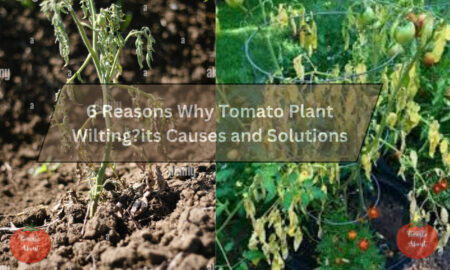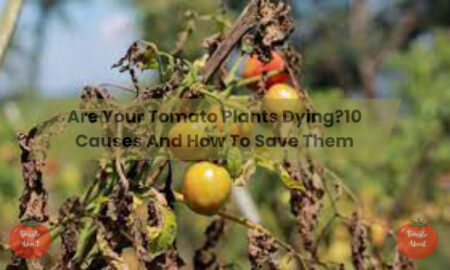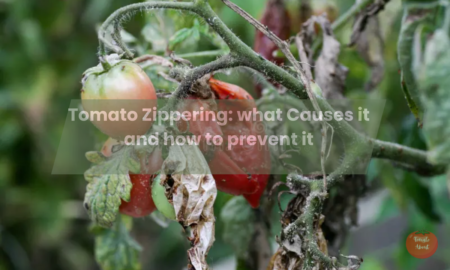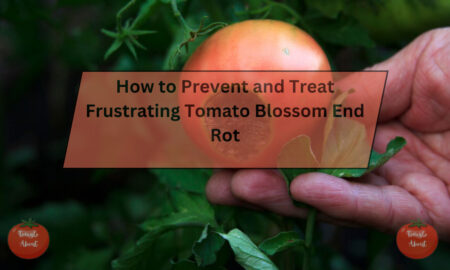Growing tomatoes is a beloved pastime for many gardeners, but it’s not without its challenges. One of the biggest obstacles faced by tomato growers is the ever-present threat of pests. These unwelcome visitors can quickly turn a thriving tomato plant into a wilted, fruitless disappointment. That’s why it’s crucial to be armed with knowledge about the most common tomato pests, their identifying characteristics, and effective control methods.
In this in-depth guide, we’ll explore the 14 most prevalent tomato pests, arming you with the information you need to identify and combat these garden invaders. From tiny sap-suckers to ravenous caterpillars, we’ll cover a wide range of pests that can wreak havoc on your tomato crop. So, let’s dive in and equip ourselves with the knowledge to protect our precious tomato plants!
14 Most Common Tomato Pests
- Aphids
When it comes to tomato pests, aphids are among the most notorious. These pear-shaped, sap-sucking insects, particularly the blackflies and greenflies, are known to affect a wide variety of fruits and vegetables, including our beloved tomatoes.
While a few aphids might seem harmless, their true strength lies in numbers. Large infestations of these tiny creatures can quickly drain the vital nutrients from plant stems, stunting the growth of your tomato plants and potentially leading to their demise.
Identifying Aphid Infestations:
- Due to their small size, spotting a lone aphid can be challenging.
- However, these pests often congregate in clusters, making them easier to detect.
- Regularly inspect the undersides of leaves, where you’ll likely find groups of green or black bugs, approximately 1/8-inch long.
Controlling Aphids:
- Start by pruning away any heavily infested foliage to reduce the aphid population.
- If the problem persists, consider introducing natural predators like ladybugs and lace bugs, which will feast on the aphids without harming your tomato plants.
- Insecticidal soaps and horticultural oils can also be effective in controlling aphid infestations.
- Fruitworms
Tomato fruitworms, the larvae of adult moths found throughout North and South America (ranging from Canada to Argentina), are among the most damaging tomato pests. What makes these pests particularly destructive is their ability to burrow tiny holes early in their life cycle, allowing them to wreak havoc on your tomatoes from the inside out.
Identifying Fruitworm Infestations:
- Keep a close eye out for the creamy-white eggs laid on your plants’ leaflets by adult moths.
- If the larvae hatch and burrow into the fruit before you notice them, they can go undetected until your tomatoes start to rot from the inside.
Controlling Fruitworms:
- Encourage the presence of natural predators like pirate bugs and big-eyed bugs, which will help keep the fruitworm population in check.
- In severe infestations, consider using organic or botanical insecticides specifically designed for controlling fruitworms.
- Leaf-Footed Bugs
Leaf-footed bugs, including stink bugs and squash bugs, are ubiquitous pests that often go unnoticed due to their prevalence. However, these stealthy insects are known to feed on more than 50 different trees and plants, including our beloved tomatoes. Thriving in hot weather, they are especially prevalent in southern regions during the spring, summer, and fall months.
Identifying Leaf-Footed Bug Infestations:
- Many leaf-footed bugs share a similar appearance, often sporting a green or brown hue and measuring roughly 3/4-inch long.
- While they may not cause direct damage to the fruit, these pests can carry viruses that lead to deformed, immature tomatoes.
Controlling Leaf-Footed Bugs:
- As an immediate solution, you can handpick these bugs from your plants and dispose of them.
- Alternatively, consider planting companion plants like buckwheat, garlic, lavender, or chrysanthemums nearby, as their strong aromas can help deter leaf-footed bugs.
- Slugs and Snails
While slugs and snails may not be the most appealing guests in our gardens, they play an essential role in the ecosystem. However, large populations of these slimy creatures can significantly hinder the growth of your tomato plants, especially when they are young and vulnerable.
Identifying Slug and Snail Infestations:
- Slugs and snails are among the largest tomato pests you’ll encounter, making them relatively easy to spot with the naked eye.
- Regular inspections of your plants, particularly in the early morning or after rain, can help catch infestations early.
Controlling Slugs and Snails:
- There’s no quick fix for dealing with large slug and snail populations, but setting up traps to drown them overnight can help reduce their numbers.
- The best approach is a preventative one: encourage the presence of their natural predators, such as birds, frogs, and certain beetles, in your garden.
- Borers
Like fruitworms, borers are a type of caterpillar that can cause significant damage to your tomato plants by burrowing into them. The stalk borer, specifically, is a purple-colored caterpillar that preys on tomato plants and can be found throughout most of the United States.
Identifying Borer Infestations:
- Newly hatched borers are much harder to spot than their adult counterparts due to their small size.
- Look for signs of disease or decay at the stems and foliage, as borers do most of their damage in these areas.
Controlling Borers:
- Frequent pruning and weed control are two effective methods for eliminating borers.
- If you notice any infested plants, cut them down immediately to prevent the spread of these pests to healthy plants.
- Beetles
Several species of adult beetles, including blister beetles, Colorado potato beetles, and flea beetles, can threaten your tomato crop as well as other plants you’re growing. Some beetles cause minimal damage, while others can leave your tomato plants in tatters.
Identifying Beetle Infestations:
- Make a habit of inspecting all areas of your tomato plants, as beetle infestations can occur on any part of the plant, depending on the species.
- Beetles vary in appearance, with blister beetles having black bodies and red heads, Colorado potato beetles sporting alternating black and yellow stripes, and flea beetles being entirely black.
Controlling Beetles:
- There’s no one-size-fits-all solution for eliminating beetles, as different types respond to different methods.
- Research the specific beetle you’re dealing with and take appropriate measures, being careful when handling them, as some species can be harmful to humans as well.
- Encouraging natural predators like birds, praying mantids, and certain beneficial insects can also help control beetle populations.
- Thrips
Thrips are miniature, narrow insects with four wings that can cause significant damage to your tomato plants. Unlike many other tomato pests, they inflict most of their damage by carrying the wilt virus, which can be devastating for seedlings and young plants.
Identifying Thrip Infestations:
- While thrips themselves are tiny and difficult to spot without magnification, they often leave trails of brown spots on your tomato leaves, making their presence more conspicuous.
Controlling Thrips:
- Once you notice the signature trail of dark spots, remove any infected plants and prune any infested foliage to prevent the spread of the virus.
- Encourage the presence of ladybugs and certain birds, as they are natural predators of thrips and can help keep their populations under control.
- Cutworms
Cutworms are soil-dwelling caterpillars that can wreak havoc on your tomato seedlings by chewing through their delicate stems. These aggressive grubs need very little time to annihilate a newly planted crop, making them a significant threat to young tomato plants.
Identifying Cutworm Infestations:
- While you might spot cutworms anywhere on the plant, they do most of their damage at the base of the stem.
- Keep an eye out for cream-colored grubs that stand out against the dark brown soil surface.
- In severe infestations, consider using organic insecticides or beneficial nematodes specifically designed to target cutworms.
- Hornworms
Before developing into the majestic five-spotted hawk moths, hornworms spend much of their youth as ravenous caterpillars, terrorizing crops like tomatoes. These common pests are prevalent throughout Australia and North America, particularly in the northern United States.
Identifying Hornworm Infestations:
- These large, green caterpillars can be difficult to spot, as they blend in seamlessly with the green foliage they prefer to munch on.
- However, they often leave telltale trails of black droppings on leaves, which can alert you to their presence.
- Against the deep red hues of ripe tomatoes, their bulky green bodies tend to stand out.
Controlling Hornworms:
- Due to their sizeable nature and sluggish movements, most hornworm infestations are manageable through manual removal.
- Carefully handpick these caterpillars from your plants, being cautious not to squeeze them, as they can release unpleasant fluids.
- Encourage natural predators like birds, wasps, and certain beneficial insects to take up residence in your garden.
- Whiteflies
Whiteflies are sap-sucking insects that, much like aphids, steal vital nutrients from healthy plants, limiting crop yields and vigor. Additionally, these pesky whiteflies can spread viruses from plant to plant, compounding their negative impact on your tomato crop.
Identifying Whitefly Infestations:
- Despite their minuscule size (approximately 1/32-inch long), whiteflies are easy to spot due to their bright white appearance against the backdrop of red tomatoes or green foliage.
- Look for clusters of these tiny, moth-like insects on the undersides of leaves.
Controlling Whiteflies:
- Prune away any heavily-infested foliage to reduce the whitefly population.
- Release natural predators like ladybugs, lacewings, and pirate bugs, which will feast on whiteflies without harming your plants.
- Insecticidal soaps, horticultural oils, and reflective mulches can also help deter and control whitefly infestations.
- Spider Mites
Spider mites are tiny arachnids most commonly found in cool weather regions and indoor facilities like greenhouses. These pests pierce the leaf surface of tomato plants, draining them of essential nutrients and reducing plant vigor.
Identifying Spider Mite Infestations:
- In the early stages, spider mite infestations can be difficult to identify, as they leave behind only faint webbing and speckling on leaves.
- As the infestation progresses, you’ll notice yellowing and dropping of infested leaves, as well as visible webbing.
Controlling Spider Mites:
- Maintain proper plant care, ensuring your tomato plants are adequately watered and fertilized, as stressed plants are more susceptible to spider mite infestations.
- Carefully prune any heavily infested foliage, and consider using horticultural oil sprays or insecticidal soaps to control the population.
- Encourage the presence of natural predators like ladybugs, predatory mites, and lacewings.
- Wireworms
Wireworms, the larval stage of click beetles, are underground pests that can cause significant damage to your tomato crop by attacking the roots, stems, and even fruits of your plants.
Identifying Wireworm Infestations:
- Keep a close watch on your seedlings and young plants, as they are particularly vulnerable to wireworm attacks.
- While wireworms typically start at the root, they often inch their way up through the main stem, leaving behind telltale tunnels and entry holes.
Controlling Wireworms:
- Attracting birds to your garden can be an effective way to control wireworm populations, as various species feed on these grubs.
- Consider using beneficial nematodes or organic insecticides specifically designed to target wireworms in the soil.
- Maintaining healthy soil with ample organic matter can also help deter wireworms.
- Nematodes
Nematodes, also known as tomato eelworms, are microscopic roundworms that live in the soil and can be a major problem for tomato growers. With over 20,000 different species worldwide, the root-knot nematode is the species that typically affects tomato plants, creating knobby roots that prevent the plants from absorbing essential nutrients.
Identifying Nematode Infestations:
- The first sign of a nematode infestation is often plant discoloration and stunted growth.
- The most blatant indicator is the presence of knobby, gall-like growths on the root system when the plant is lifted from the soil.
Controlling Nematodes:
- Nematodes are notoriously difficult to manage, as they play an important role in controlling other garden pests while simultaneously causing damage to tomato plants.
- If you have a severe nematode problem, focus on growing nematode-resistant tomato varieties until their populations have subsided.
- Soil solarization, crop rotation, and the use of beneficial nematodes can also help reduce nematode populations in your garden.
- Psyllids
Psyllids are plant lice capable of jumping from plant to plant, making them highly mobile pests. Resembling miniature cicadas, these sap-suckers can inflict significant damage and are considered among the biggest threats to tomato plants in certain regions.
Identifying Psyllid Infestations:
- The toxic saliva of psyllids can cause a condition known as “psyllid yellows,” leading to yellowing and dropping of foliage.
- These pests also leave trails of a sugary substance, known as honeydew, on leaves and surrounding surfaces.
Controlling Psyllids:
- In some cases, harsh winter conditions can naturally eradicate psyllid infestations, as these jumping plant lice cannot survive extreme cold.
- Encouraging the presence of spiders, birds, and predatory insects like lacewings and pirate bugs can help control psyllid populations.
- In severe infestations, consider using insecticidal soaps, horticultural oils, or targeted insecticides specifically designed for psyllid control.
Conclusion
As you can see, tomato pests come in various shapes and sizes, each with their own unique tactics for attacking your beloved plants. However, by staying vigilant, identifying infestations early, and employing the appropriate control measures, you can emerge victorious in the battle against these formidable foes.
Remember, a little bit of knowledge and preventative action can go a long way in ensuring a bountiful tomato harvest. So, keep those tomato pests at bay, and enjoy the fruits of your labor – quite literally!
If you’ve had any experiences with these pesky invaders or have additional tips to share, we’d love to hear from you in the comments below. Happy gardening, fellow tomato enthusiasts!








